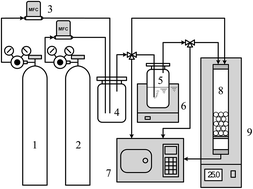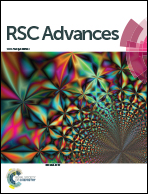Pretreated multiwalled carbon nanotube adsorbents with amine-grafting for removal of carbon dioxide in confined spaces
Abstract
Three different methods, including thermal treatment, treatment with HNO3 and O2 oxidation, were used to pretreat multiwalled carbon nanotubes (MWCNTs) before grafting with N-(2-aminoethyl)-3-aminopropyltrimethoxysilane (AEAPS). The types and contents of the O-containing groups generated by the various pretreatment methods were quantified and the corresponding amine-grafting reactions investigated. The alkoxyl groups of AEAPS react with the O-containing groups on the pretreated MWCNTs through silylation reactions in which there is no carboxyl acids induced by O2 gas oxidation. The grafted primary amino groups can be accessible to capture the maximum amount of CO2. A dynamic fixed-bed system was used to characterize the adsorption behavior of low concentrations of CO2. The adsorption/desorption operations of 10 repeated cycles were investigated to verify the sustained excellent performance. The highest CO2 adsorption capacity of 0.64 mmol g−1 was achieved by the O2-oxidized MWCNTs with AEAPS-grafting, which is almost 7.1 times the CO2 adsorption capacity of the oxidized MWCNTs without amine-grafting. This indicates that O2 gas oxidation is simple to operate and highly efficient for the pretreatment of MWCNTs. The adsorbent obtained has a high capacity, high thermal stability, high tolerance to moisture and low regeneration cost and shows promise for the direct capture of low concentrations of CO2 in confined spaces.


 Please wait while we load your content...
Please wait while we load your content...